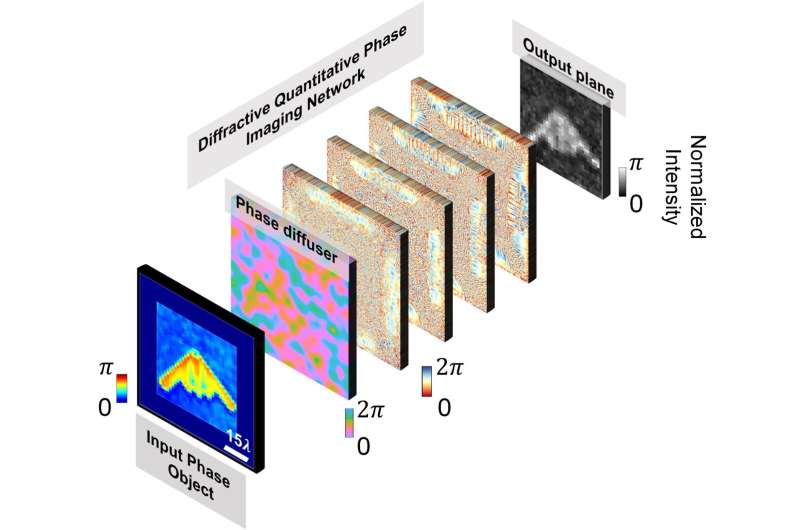This article has been reviewed according to Science X's editorial process and policies. Editors have highlighted the following attributes while ensuring the content's credibility:
fact-checked
trusted source
proofread
Diffractive networks enable quantitative phase imaging (QPI) through random diffusers

For decades, imaging weakly scattering phase objects such as cells has been an active area of research across various fields, including biomedical sciences. One common approach uses chemical stains or fluorescent tags to bring image contrast to weakly scattering objects, but it requires relatively complex sample preparation steps, which can also be toxic or destructive to samples. Quantitative phase imaging (QPI) has emerged as a powerful label-free solution to this need, providing non-invasive, high-resolution imaging of transparent specimens without using any external tags or reagents.
However, traditional QPI systems can be resource-intensive and slow, due to their need for digital image reconstruction and phase retrieval algorithms. Moreover, most QPI approaches do not account for random scattering media, especially prevalent in biological tissue.
In a recent paper published in Light: Advanced Manufacturing, a research team led by Professor Aydogan Ozcan from the Electrical and Computer Engineering Department at the University of California, Los Angeles (UCLA) reported a new methodology for quantitative phase imaging of objects that are completely covered by random, unknown phase diffusers. Their method uses a diffractive optical network composed of successive transmissive layers optimized via deep learning, and this diffractive system axially spans ~70λ, where λ is the illumination wavelength.
During its training, various randomly generated phase diffusers were utilized to build resilience against phase perturbations created by random unknown diffusers. After the training, which is a one-time effort, the resulting diffractive layers can perform all-optical phase recovery and quantitative phase imaging of unknown objects that are entirely hidden by unknown random diffusers.
In their numerical simulations, the team successfully demonstrated the capability of the QPI diffractive network to achieve imaging of new objects through new random phase diffusers that were never seen before. In addition, their research delved into the impact of various factors, such as the number of spatially-structured diffractive layers and the trade-off between image quality and output energy efficiency, revealing that deeper diffractive optical networks could generally outperform shallower designs. This QPI diffractive network can be physically scaled to operate at different parts of the electromagnetic spectrum without redesigning or retraining its layers.
Such an all-optical computing framework possesses the benefits of low power consumption, high frame rate, and compact size. The UCLA research team anticipates the potential integration of their QPI diffractive designs onto image sensor chips (CMOS/CCD imagers), effectively transforming a standard optical microscope into a diffractive QPI microscope capable of performing on-chip phase recovery and image reconstruction through light diffraction within passive structured layers.
More information: Yuhang Li et al, Quantitative phase imaging (QPI) through random diffusers using a diffractive optical network, Light: Advanced Manufacturing (2023). DOI: 10.37188/lam.2023.017




















